2016 – Ten Years on the Farm

A look back at the founding, building, and overall impact of the Gateway Greening Urban Farm.
The Gateway Greening Urban Farm (formerly known as City Seeds) started out as most things do – as a “what if?” floating around the organization back in 1998. For a nonprofit dedicated to addressing food security issues through the establishment of community gardens, starting a farm that could produce more fresh produce and reach a greater number of people seemed like a natural extension of their existing programs. Pretty soon, that “what if?” transformed itself to a “how?”
Building Partnerships
To figure that out, the Gateway Greening staff went on a retreat to brainstorm what a St. Louis based urban farm should look like, and how it could be used to serve and benefit the surrounding community. The staff quickly realized that by partnering with other nonprofits and public organizations, they could significantly expand the opportunities the farm presented. With a wish list in hand, then executive-director Gwenne Hayes-Stewart began to reach out to organizations they’d like to partner with. Many of the potential partners she approached to play a role responded with an “oh cool, yes!” – provided that funding could be found to support it. According to Gwenne, it was a fun time, but a lot like starting a whole new organization.
Ultimately, Gateway Greening formed a coalition with St. Patrick Center, Missouri Botanical Garden, St. Louis Master Gardeners, Public Policy Research Center (PPRC) of UMSL, St. Louis Community College at Meramac, and Operation Food Search. By combining their unique resources and skill sets, the coalition was able to secure a Community Food Project Grant through the USDA Cooperative State Research, Education, and Extension Service (CSREES) to fund the project’s initial starting costs and early operational budget.
Under the original CSREES grant, the urban farm’s mission was listed as “Improve access to fresh food at low cost, improve self-sufficiency for people overcoming addiction.”
Roles of the Original Coalition Members: 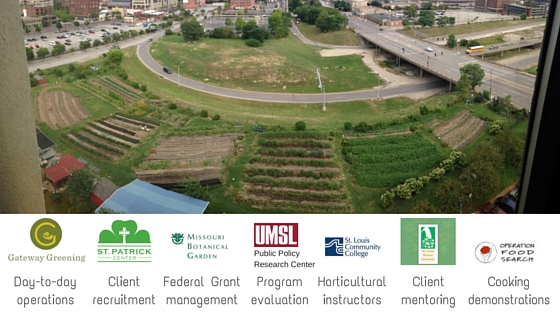
Building the Gateway Greening Urban Farm
Everything seemed to be coming together: the project had a solid plan, a coalition of organizations that would work together to make the project a success, and the funding to make it happen. What they didn’t have was land.
Hayes-Stewart recalls this time period with a sense of frustration. All of the sites originally proposed had major impediments, from extensive sidewalks and hardscaping throughout the plot to deep shade caused by surrounding buildings. Fortunately Kevin McGowan, a Gateway Greening Board Member, had a solution. At the time, the Missouri Department of Transportation (MODOT) had a sizeable piece of land bordering an on-ramp for Highway 64/40, just a stone’s throw from downtown St. Louis. Coming in at 2.5 acres, the plot turned out to be an ideal location – plenty of sun, highly visible, and located close enough to St. Patrick Center to be accessible to the clients who would be working there. The contact at MODOT thought it was a great idea, and agreed to lease the property.
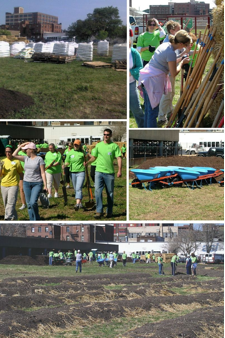
Although the land was perfect in many ways, the soil was not. Soils in most urban areas are typically referred to as ‘brownfields’ meaning the soils are poor quality and are often contaminated with industrial chemicals or other pollutants. At the time, Gateway Greening had a board member who worked in the marketing department at what is now Spectrum brands, who was able to arrange for a donation of soil that could be used to create raised berms. This would allow the farm to grow healthy food above the site’s contaminated soil. The initial plan was to create 10 berms each year over the life of the grant (3 years) for a total of 30 beds. However, that’s not quite how things played out.
One of the many things that Spectrum has sold over the years is bagged potting soil. And much like food, potting soil must be appropriately labeled in order for a business to legally sell it within the US. At some point in time, Spectrum’s production line had mistakenly bagged a large amount of potting soil in the wrong packaging, rendering it un-sellable. It sat stockpiled in a warehouse in Kentucky until the Spring of 2006. Thanks to the generosity of Spectrum and a dedicated volunteer base, all 30 of the Farm’s planned raised berms were built over a period of 2-3 months using 6 tractor trailer loads of mislabeled bagged potting soil and humus. According to Annie Mayrose, the first Farm Manager, the soil for most berms had to be laid by hand, one wheelbarrow at a time, because it wasn’t possible for heavy equipment to reach all areas of the farm, nor was there enough room for a skid steer to operate in-between beds. Ten years later, she’s still grateful to Horstmann Brothers Landscaping for donating their time and equipment to move pallets of bagged soil as close to their eventual home as possible.
Working with St. Patrick Center Clients
The beds weren’t the only thing to see explosive growth in the first season. In addition to growing food, the Farm was intended to be a place where individuals who were dealing with mental illness, overcoming addiction, homelessness, and other challenging circumstances could work part-time in conjunction with their therapy programs. The idea was that by working on the farm, clients would be able to reinforce their personal and therapeutic goals by seeing first hand what they were capable of – growing food. That would help at-risk individuals in their community, gaining self-confidence as they accomplished tasks and saw their crops thriving, and developing a healthy relationship with food,learning soft skills and the importance of a nutritional diet. The grant originally intended to serve 10 clients the first year, however, 53 clients passed through the program before the first November.
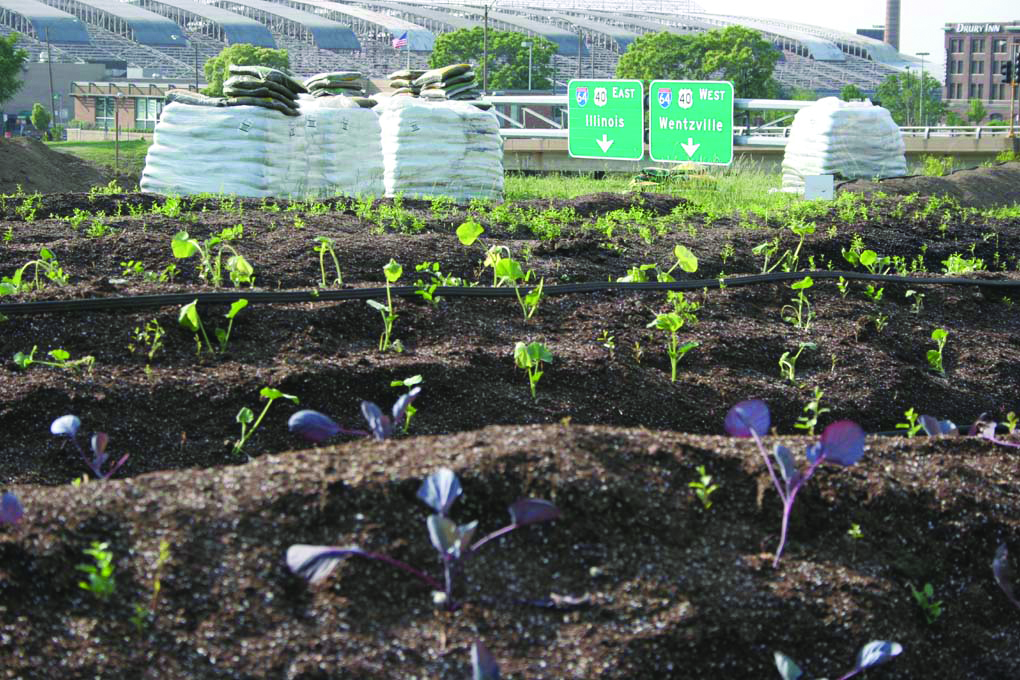
Fact: The berms of the Gateway Greening Urban Farm are not straight rows, but gently undulating lines. The design was done by Master Gardener Sue Chaires to mimic the movement of the Mississippi.
Between the combined efforts of clients, staff, and volunteers, the Gateway Greening Urban Farm produced 2,200lbs of produce in its first year. Much of the produce was sold at the nearby Tower Grove Farmers Market as a way to introduce the clients to retail sales and customer service while improving their self-confidence and putting food into the community.
Pilot Food Box Program
2006 was also the year that the Gateway Greening Urban Farm partnered with what is today City Greens and other existing Gateway Greening community garden sites to pilot a food box program that sought to connect rural, low-income farmers with people living in St. Louis food deserts. This endeavor was essentially a subsidized Community Supported Agriculture (CSA) program. It was a great idea, but needed a bit of tweaking. It quickly became obvious that many of the food box recipients had no experience with many of the fruits and vegetables they were receiving, so seasonal recipes and cooking resources were quickly implemented to meet the need. The Pilot Food Box Program did well for a number of years, but eventually the funding that made the subsidies possible ran out, making the boxes too expensive for the individuals who needed it. When that happened, the program became the foundation for what is today City Greens: a grocery Co-op that keeps prices affordable for everyone in their community!
2007-2009
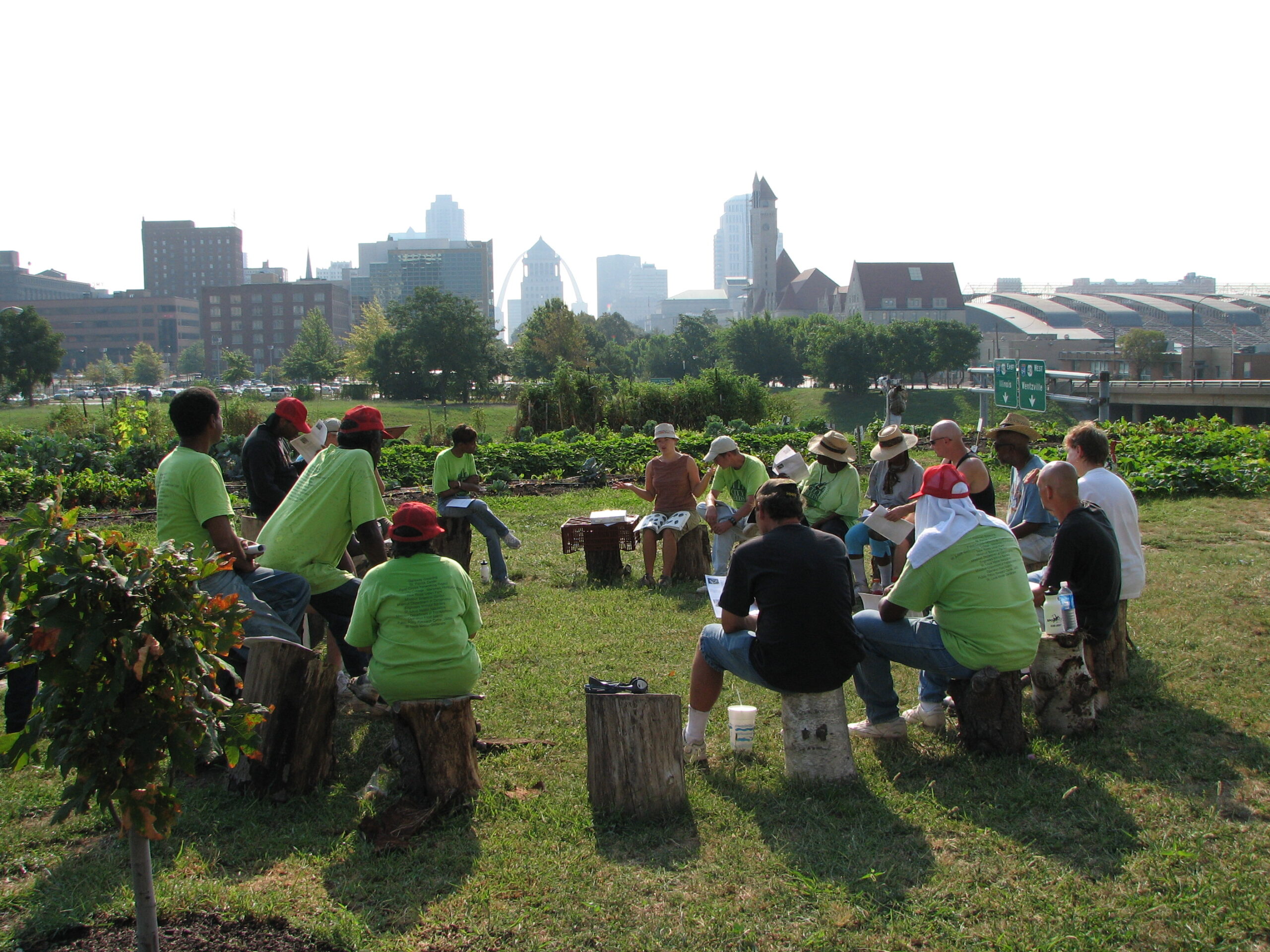
When asked, Mayrose is honest about the growing pains experienced during this period. She went on to explain that each year the amount of produce grown increased, causing a scramble to find enough refrigerator space to hold the food until it could be distributed. The office was quite a ways from the farm, meaning that the harvest, mowers, gas and larger items had to be loaded up into a truck and carted across St. Louis at least twice a day. And the temporary shade structures being used kept being destroyed during surprise thunderstorms.
Despite these challenges, there were hundreds of daily high points too. Mayrose also talks about what it was like to see people interacting out on the farm and the joy and sense of accomplishment the work brought to everyone. Mary Fitz, a former client who completed the Job Training program in 2008, agrees: “My life really started changing there. To see nothing, then, I was taught how to plow, to turn over the soil, and I even helped build an irrigation system. You know, I learned to garden…it was just an amazing experience.”
Even during the early years, the Gateway Greening Urban Farm drew volunteers from everywhere: Corporate CEO’s, people struggling with homelessness, high schoolers, retiree’s, and even international visitors from the hotel next door! The shared life experiences and interactions from these diverse groups made even the most daunting, physical farm task fun and meaningful.
Did you know? The Farm’s current location was formerly a backup landing pad for the nearby Children’s Hospital in the event high winds prevented a normal landing. During the early years, helicopters still occasionally landed on The Farm!
2009 – 2010 – Awards & Grants
The original CSREES grant ended, causing several changes as some organizations parted ways, and others, like Food Outreach, were added. By bringing in new partners and expanding the farm’s official focus to include more defined roles for both food distribution and education, the coalition was able to acquire a second CSREES grant that would serve as the primary funding of The Gateway Greening Urban Farm for another 3 years. While the CSREES grant was important, it wasn’t nearly as fun as the Pepsi Refresh competition!
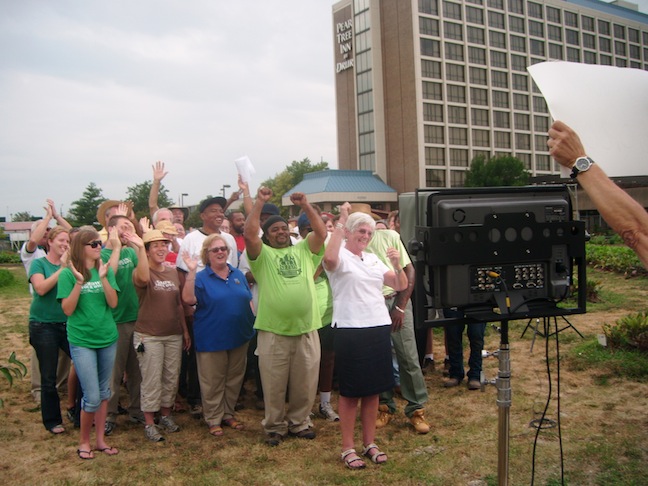
At the same time, it became apparent that St. Patrick Center clients who had worked on the farm were getting hired by local landscape companies and nurseries because of their experiences growing crops. 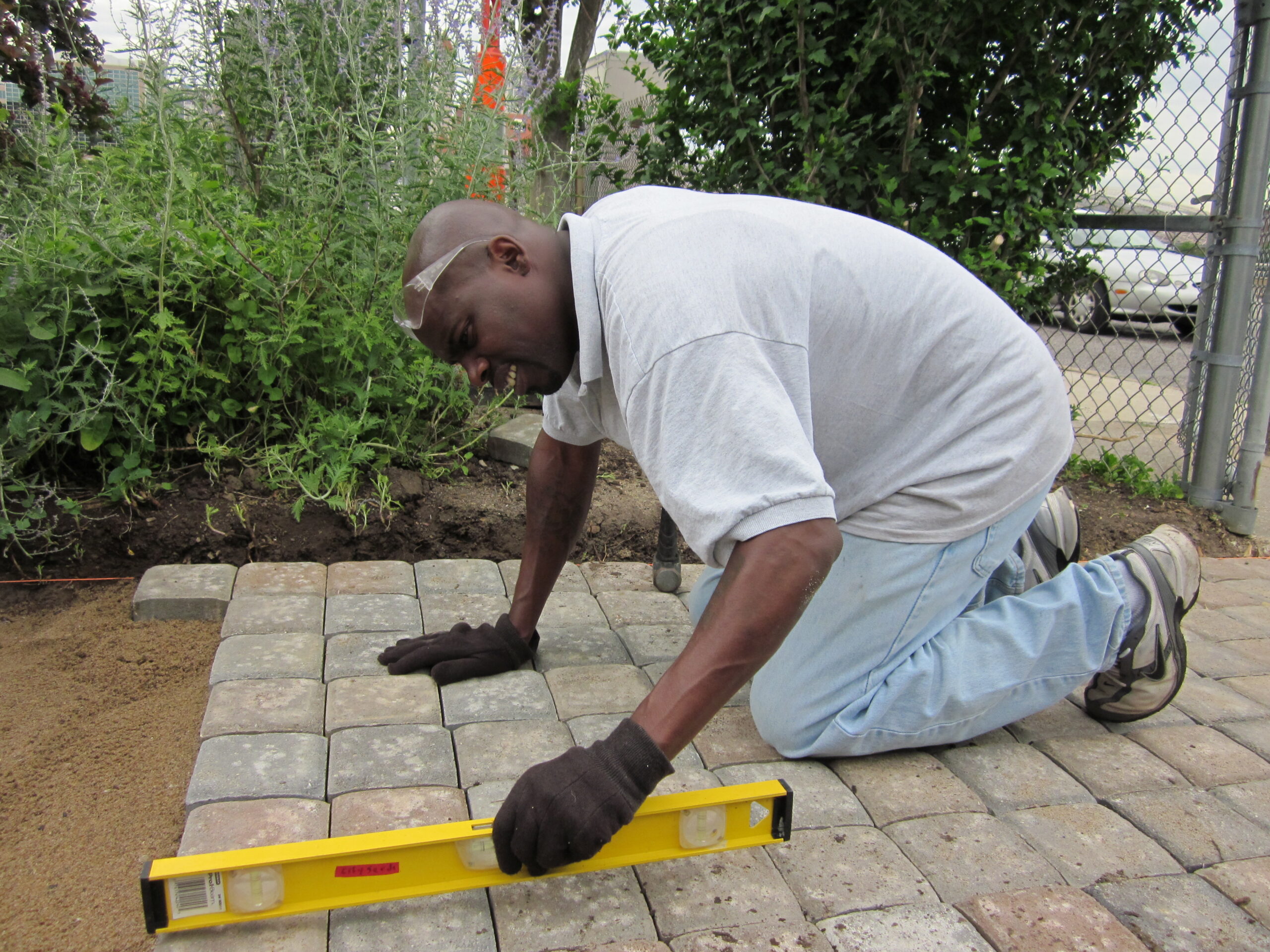
The program was initially funded by a one year grant through the Wal-mart Foundation, then sustained long term when St. Patrick Center was 1 of 6 national winners to be awarded a Green Jobs Training Initiative Grant by the US Conference of Mayors. The Therapeutic Horticulture Program continued as a separate offering.
Beehives were also added to the farm in 2009, and production jumped to 10,000lbs a year as soil quality continued to improve.
6 Years In…
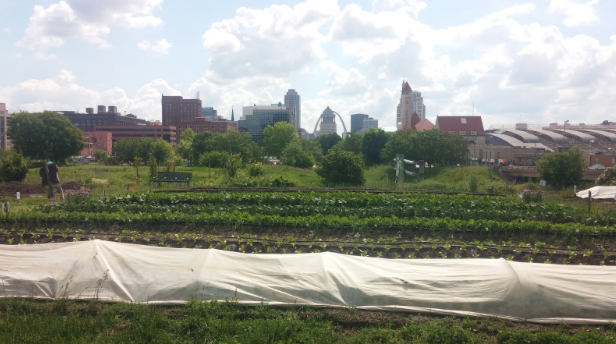
1. The addition of a large shade structure, courtesy of a Specialty Crop Grant through the Missouri Department of Agriculture. This structure shelters the outdoor classroom, making it the perfect day for class on rainy days and offering a crucial cool space for clients and volunteers during the worst of summer’s heat.
2. The Mobile Mini shed was also added for secure tool storage after the site experienced multiple break-ins and robberies, resulting in the loss of expensive landscape equipment.
3. The installation of a rain garden in the center of the farm by then AmeriCorps VISTA Rachel Deffenbaugh. Although they’re well covered with grass and plants today, the farm is a network of french drains that move excess water to the rain garden where native plants trap and utilize the water, filtering it before it permeates back into the ecosystem. This project was crucial to reducing standing water on the site.
Changes on the Gateway Greening Urban Farm

Programming on the farm has evolved as well. For a time, the job training track included the Veterans Go! Green Job training program (created in conjunction with St. Patrick Center) which provided struggling military veterans with hands-on green industry job skills training and a basic horticulture education.
“We were all sharing a common bond. We all started getting attached to these plants, and the amazing process that not only the plant were going through but we were in ourselves experiencing the growth and the change.” – Greg Roger, former client.
What hasn’t changed is the Gateway Greening Urban Farm’s commitment to continuing to serve St. Patrick Center clients who are working to overcome homelessness, addiction, mental health issues and recidivism. As the economy recovered from the 2008 recession, our staff has seen a higher concentration of clients who need both the job training and therapeutic horticulture programs, resulting in the blending of these two distinct programs in 2016.
In a recent interview, Deffenbaugh was asked if there was a client that particularly stood out in her memory. “Several” she admits, “but Allen, a therapy client from 2012, probably stands out the most” (name changed, for confidentiality reasons). Before joining the program Allen had been a single parent, supporting his kids by truck driving. Like many drivers, Allen began to abuse drugs in order to stay awake and on the road longer in an effort to get his runs done quickly, and wound up addicted. From there, things spiraled out of control. “He’d had a rough time of things,” recalls Deffenbaugh, who has stayed in touch with Allen since he successfully completed the job training program in 2013. “When he started the program, he’d been sober for maybe a month – he always credited the program for helping him stay sober.” After completing the program, Allen went on to rebuild his life, finding both a stable home and work that allowed him to spend more time with this family. “He still volunteers with us” Deffenbaugh mentions at the end of the interview. “He’s always a big help when he visits.”
10 Year Impacts:
Over the last ten years, the Gateway Greening Urban Farm has produced more than 105,000 pounds of fresh, nutritious produce that has been distributed throughout the St. Louis region: to St Patrick Center clients and volunteers, to CSA and market customers, to food pantries, to food-security non-profits and to the City Greens cooperative. The Therapeutic Job Training Program – across all its incarnations – has helped more than 633 men and women to develop valuable technical and interpersonal job skills, as well as to develop coping skills in order to address challenges with mental illness and substance abuse. And the Gateway Greening Urban Farm has brought together thousands of volunteers from all over the region (and world!) to share stories and experiences as they work side by side between the berms.
When it’s all said and done, I could quote numbers: production quantities, volunteer hours, and employment rates galore, but the true impact of the Gateway Greening Urban Farm isn’t measured in numbers. It’s found in people like Mary Fitz and Willie McFarland. Eight years after finishing at the Farm, Fitz is still putting her skills to use at Global Market, where she preps, wraps, and displays delicious peppers and other produce in their produce department, and still loves to garden at home. As for McFarland, he’s been back to the farm on several occasions as a teacher, training new groups of clients in the skills and techniques he regularly uses in his work for Horstmann Brothers Landscaping. I can’t help thinking that he summed up the entire farm experience best when we spoke last: “It opens up doors, so many other doors to opportunities that weren’t there. When I look at the options this opened up since I learned this… I literally got a skill I can use that betters the whole situation, for me and everybody associated with me.”
Researched and Written by Erin Wood, AmeriCorps VISTA
Edited by Annie Mayrose, Rachel Deffenbaugh, and Jenna Davis

